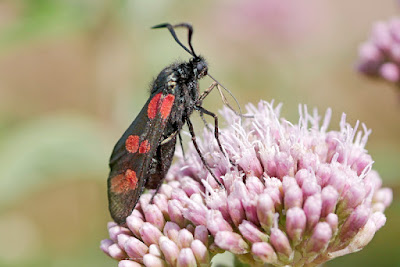As well as having access to expert botanists on field trips, another big plus is that field trips sometimes take you to out of bounds areas that others cannot explore. This was one such trip to Penhale Sands near Ellenglaze which is a MOD training area, which is behind barbed wire and guarded.
This was a sunny, warm day and before the drought had started properly, so the plants were still fresh. The area comprised mainly of fixed sand dunes with plenty of dune slacks, some with standing water in them and others that dry out leaving a damp area. Perfect for many of our rarer plants to thrive.
Whilst waiting to get started, I noticed a big stand of Babington's Leek, a large plant and one that can't be missed when in flower. They are relatively common around coastal areas and I saw some flowering today (20/08/22 at the time of writing) much further north at Crackington Haven too.
Allium ampeloprasum var. babingtonii
Dactylorhiza x hallii
It took a while to find the Marsh Helleborines, even though we knew where they should be. This was because only a few had come into flower, with the rest still in bud. This made it very hard to see them and to avoid crushing budding plants, we trod in each other's footsteps to minimise habitat damage. These flowers were narrower than usual, but I think that was because they were very fresh and had just opened.
We did find some and another small colony in a nearby dune slack too. I think Rock dunes are the only other place they are found in Cornwall.
Epipactis palustris
Portland Spurge is a very attractive native plant and it was dotted around the dunes in the drier places.
Euphorbia portlandica
Near the helleborines were hundreds of the rare Flat Sedge, a plant I'd not seen before. It really is flattened and compressed in fruit, so it's easy to identify. However, it is also confined to this site only within Cornwall, so it is unlikely I will find it elsewhere in the county.
Blysmus compressus
Someone then spotted the most tiny Gentian I'd ever seen in the short turf. On looking closer we found lots more. It was the Early Gentian, a species I had searched for and failed to find in Kent in years gone by, so another new species for me. This used to be classified as a very rare endemic species only found in the UK, however, taxonomists have since downgraded it to a subspecies of Autumn Gentian. Regardless, it is quite different to Autumn Gentian in appearance being much shorter and it flowers much earlier and is thus worthy of protection.
My small eye loupe to give some scale.
Of course, there was an abundance of common flowers too, most of which do not get photographed. One of these was Common Centaury, which looked so bright and cheerful in the sun, I gave in and took its portrait anyway.
Centaurium erythraea
Most Eyebrights are difficult to identify, but the four sided structure of Western Eyebright is distinctive. Only found in coastal locations (to date) it was abundant here.
Euphrasia tetraquetra
There was another orchid to see and it was just coming into flower. It was another new species for me, the Marsh Fragrant Orchid. This species is most likely absent in Kent and I never did find any. It does look quite different to Chalk Fragrant and even the smell is different too.
Gymnadenia densiflora
In one of the drying up ponds was a arge stand of Watercress. Mixed in with it was the rarer One-Rowed Watercress, another new species and one I hadn't heard of before. There are hybrids here, but I couldn't find any mature enough seeds to find it.
Nasturtium microphyllum has one row of seeds, N. officinale has two as shown below.
Also in this pool were hundreds of plants of Common Clubrush with their distinctive heads and blue green stems. This is now mostly confined to this area of Cornwall too.
Schoenoplectus lacustris
Our VC2 county recorder amongst the Common Club Rush
Another plant that likes to keep its roots wet and grows around the draw down line of ponds is this Lesser Water Plantain below. The leaves shown however, belong to another plant, Marsh Pennywort.
Baldellia ranunculoides
The final plant we went to see was Variegated Horsetail and we walked quite a way across the dunes to find it. When we arrived at the right place, we were all on our hands and knees looking for it and it took some minutes before we did find it. It was very small and intertwined around Creeping Willow, so really hard to see and to photograph too. Another first for me too.
Equisetum variegatum
There was also an abundance of butterflies, beetles, grasshoppers and crickets and insects in general, here are just a few of those seen.
Female Silver Studded Blue
Great Green Bush-Cricket
5 Spot Burnet Moth - Zygaena trifolii
Poplar Leaf Beetle
So ended a memorable field trip. Not only did I see many species of plants I hadn't seen before, but I also met fellow botanists and staff from Cornwall Wildlife Trust, thus making contacts too. I can't recommend strongly enough that you seek out your own local botany group and go along to a field trip or two. You will learn so much more than on a solo trip and also have access to locations you otherwise couldn't visit. The same applies to specialist groups looking for all types of insects, birds, mosses and bryophytes and so on.
For plants you can find your own local group at bsbi.org and click on your county on a map of the UK and Ireland. Good luck!
Until next time.
You can also follow me on Twitter: @Botany2021
Dave










































































